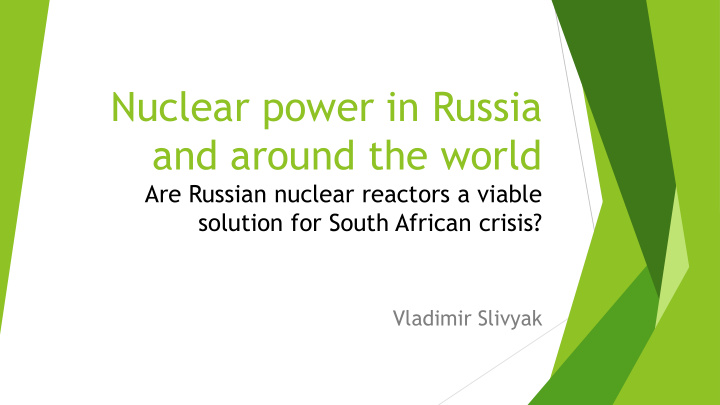



Nuclear power in Russia and around the world Are Russian nuclear reactors a viable solution for South African crisis? Vladimir Slivyak
Current situation: Russia has large but outdated energy industry – attempts to modernize it basically failed so far Primary energy in Russia – gas (55%), oil (15%), coal (20%), nuclear (5%), the rest is mainly large hydro 36 reactors, 18-19% of electricity Russian reactors are old, many have to start decommissioning during coming decade. Costs uncalculated. There is no experience with decommissioning in Russia.
Beginning Nuclear industry was established with the aim to produce nuclear material for bombs 1957 accident – largest pre- Chernobyl’ in Soviet history – 10,000 people evacuated; 20,000 sq.km contaminated Industrial scale nuclear electricity generation started in 1970s 1986 – largest civil nuke plant accident in history of humankind
Post-Chernobyl Protest movement did shut down all of reactor construction in Soviet Union Nuclear industry for a long time went to a coma and came back in 21 century with new ideas/reactors Not with solutions but with new ways to create even more problems Authoritarian Russian government is concerned about re- establishing its world’ influence which stimulates the sale of reactors abroad, especially to poor countries. Technology that mostly rejected by rich world.
Re-designing Russian industry Nuclear state corporation “ Rosatom ” established in 2007 (owned by the government but its shares can be sold whenever gov’t decides so) “ Rosatom ” claims it had a book of orders to the tune of over $100 billion (27 new reactor orders), predominantly, in developing countries. (End of 2013, $74 billion’s worth of new orders had been cited)
Only 4 countries where actually construction is going on – China, India, Iran and Belarus BOO deal in Turkey signed 7 years ago – construction of reactors is not started yet No independent assessment exist for new design Economics of new reactors remains in doubt
Anyone is there to believe? Former World Nuclear Association executive Steve Kidd: “highly unlikely that Russia will succeed in carrying out even half of the projects in which it claims to be closely involved”. (6 Oct 2014, “The world nuclear industry – is it in terminal decline?”, www.neimagazine.com/opinion/opinionthe-world-nuclear-industry-is-it-in- terminal-decline-4394815/)
What kind of animal is new Russian reactor Officially, “ Rosatom ” stated it will take 4 -5 years to build new VVER-1200 reactor and it will cost $5bln There is only 1 reactor of this type in operation in Russia, commissioned in 2016. Three more under construction. Construction of 4 reactors of this design was stopped as public was opposed to it. Alternative calculation of costs for this reactors was done in 2014 in Finland. That shows the reactor will likely cost Euro 7.7bln (close to latest EPR estimate – no cheap)
A January 2015 report by the Russian Duma’s independent Audit Chamber revealed that delayed payments for construction costs at numerous new nuclear plants are leading to cost overruns and delays. Overall, funding constraints have put seven of nine new Russian nuclear power plant builds behind schedule, according the report. At Leningrad- 2 plant’s No. 1 reactor − technical violations in construction resulted in a collapse of the unit’s reinforcement cages, which brought down the reactor’s outer protective shell in July 2011. The construction of the No 1 and 2 reactors is delayed with substantial cost overruns. Various reports on low quality of equipment and reactor components as likely result of corruption
It is unclear is safety issues existing for previous VVER designs resolved: Tritium leaks Loss of coolant accidents Sustainability under large airplane crashes … and in case of the spent nuclear fuel storage Does the core-catcher actually solves all problems?
According to the Russian nuclear regulator Rostekhnadzor, 39 incidents occurred at Russian nuclear power plants in 2013. The main reasons cited by the regulator were “mismanagement, defects in equipment and design errors.”
And across the world
Nuclear share in primary energy, 21 cent
Sources: IAEA-PRIS, MSC, 2014
Sources: IAEA-PRIS, WNA, various sources compiled by MSC 2014
Source: UNEP 2014 and WNISR original research
Source: IAEA-PRIS, EPIA, GWEC 2014
Jobs
What investors say UBS: “…within a decade, 10% of the world’s electricity will be solar -powered and, more importantly, that the growth rate of solar will only continue to accelerate… We believe solar will eventually replace nuclear and coal, and [be] establish[ed] as the default technology of the future to generate and supply electricity.” (June 2015) Citigroup: “We predict that solar, wind, and biomass continue to gain market share from coal and nuclear into the future… rising renewables generation should increasingly take over market shares of coal- and gas-fired generation, particularly in an environment of slow electricity demand growth.” ( Global Energy 2020, July 2014) Bloomberg: “The price of solar power will continue to fall… The lifetime cost of a photovoltaic solar-power plant will drop by almost half over the next 25 years… Expect $3.7 trillion in solar investments between now and 2040. Solar alone will account for more than a third of new power capacity worldwide” (June 2015)
Electricity capacity additions, in gigawatts Source: BNEF
Thank you
Recommend
More recommend